One of the best ways to get a visceral sense of what life in the Revolutionary Era was like is to eat the foods that they ate. Of course, there are challenges in this endeavor, not the least of which are changes in ingredient availability, cooking technology, labor availability and the overall culture of food.
It is possible, though, to approximate the food that our forebears enjoyed. We can substitute an electric or gas oven, controlled with an electronic thermostat, for the wood fireplace with a bread oven built in to the side. In place of indentured servants (or, let us not shrink from the historical fact, slaves), we have our KitchenAids and Cuisinarts to handle the slicing, blending and kneading labor. And in place of mutton and turtle, we have plentiful and inexpensive access to lamb and beef.
Some things, however, do not change. The feel of a good bread dough under your hands as you shape it, and the aroma as it bakes — the passage of a couple of centuries is nothing to this. The rich aroma of a good home-made broth, and the warmth of its nourishment as you savor and swallow is an historical constant.
Most of all, though, the happy sounds of people gathering around a table to take a meal together, the sense of camaraderie that shared food brings us, these are experiences that we can share directly with the founding generation of this country, and to a great degree, the details of the meal itself are unimportant in that regard.
Today, we’ll cook a relatively simple family meal (with plenty of leftovers), using recipes gleaned from a couple of my favorite modern sources for understanding food of the period.
Potato Soup
We’ll start with a potato soup[i], a meal that a Revolution-era cook might have turned to on a day when there was no meat available in the larder.
Put in a large saucepan:
3 cups (700ml) potatoes, diced
3/4 cup (175 ml) celery, chopped
1/2 cup (125 ml) onion, chopped
Add just enough boiling water to cover, and cook until tender and most of the water is absorbed.
Heat, but do not boil:
5 cups (1200 ml) milk
Add to the cooked vegetables, along with:
5 tbsp (75 ml) butter
1 tsp (5 ml) salt
pepper to taste
Heat through, but do not boil. Serve, garnished with parsley, if you like.
Molasses Graham Bread
We’ll serve this filling soup with a lovely molasses graham bread[ii], which is slightly sweet and warming – perfect for a blustery spring evening.
Preheat oven to 350° F (175° C), and grease and flour two loaf pans.
Mix together:
1/4 cup (60 ml) sugar
2 cups (250 ml) flour
2 tsp (10 ml) baking soda
2 tsp (10 ml) salt
1 tsp (5 ml) baking powder
1 3/4 cup (415 ml) graham (or whole wheat) flour
Cut in with a pastry blender (or blend in food processor) until the mixture resembles coarse cornmeal:
1/3 cup (80 ml) butter
Blend in a separate bowl:
2 eggs, beaten
1 3/4 cup (415 ml) sour milk or buttermilk
3/4 cup (175 ml) molasses
Pour into dry mixture and stir only enough to blend. Pour into prepared loaf pans and bake at 350° F (175° C) for about 40 minutes.
Jefferson’s Meringues
Finally, for dessert, we’ll visit Monticello and enjoy some simple meringues[iii], for which Thomas Jefferson apparently developed a taste during his service in Paris as the Ambassador for the young United States, enough so that he took notes on the process of making them, from which this recipe is derived.
Preheat oven to 250° F (120° C), and lay a piece of baking parchment onto a cookie sheet. Beat to a “white froth” (stiff peaks):
6 egg whites
Continue beating, and add, very gradually:
6 tbsp (90 ml) granulated sugar (or caster sugar, if available)
Place by rounded tablespoonfuls onto the baking parchment – you may find that you like to shape them a bit by passing them back and forth between two spoons, before setting them onto the parchment.
Bake at 250° F (120° C) for “as long as you wish” – in practice, probably not more than 45 minutes to an hour, depending upon whether you like them soft in the middle or darker and dried through.
Enjoy this simple trip back in time together with someone who can share wide-ranging conversations about the topics of the day. Accompany it with the ale or cider of your choice, and finish with a good strong cup of tea, and ponder the ways in which food communicates directly to our palates the flavor of the American Revolution.
EDITORS’ CONTEST: Anyone willing to video document themselves over the weekend making the recipes featured in today’s article will be entered to win a signed copy of Reporting the Revolutionary War and a limited edition faux leather journal. Plus, your video may be featured on allthingsliberty.com! Send video submissions to ed****@al**************.com by 9 pm on Wednesday, May 22 (YouTube or Vimeo links preferred). Submissions are welcome after Wednesday, but will not be eligible for the prizes.
UPDATE: The winners of our cooking contest are Jennifer and Christopher Hunt of Florida, who submitted this terrific video (embedded below) demonstrating how to cook the above recipes. Congratulations, Jennifer and Christopher! The Food Network and your colonial brethren would be proud.
[i] O’Connor, Hyla. The Early American Cookbook. Englewood Cliffs, New Jersey: Prentice-Hall, 1974. 38. Print.





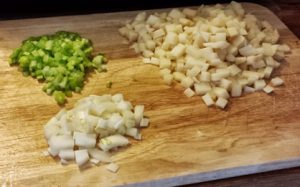


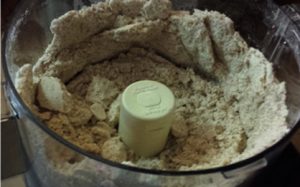

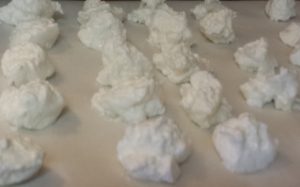

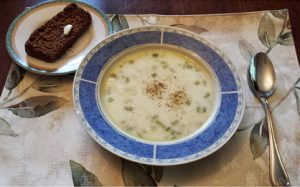
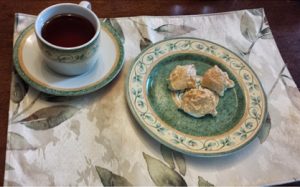




8 Comments
This is fantastic, Lars. What a great way to experience life during the American Revolution from the comforts of our own homes. As I said on Facebook, this makes for the perfect family or date night cooking project. Nice work. Who knew you were such a culinary expert, too.
Thanks very much, Todd! I’ve cooked in cuisines from all over the world – and, as they say, the past is a foreign country… 🙂
I’m looking forward to continuing this journey – already picking out recipes for the next time.
I sense a regular column coming on….
We have updated this article to include the winning video of our cooking demonstration contest. Congrats to Jennifer and Christopher Hunt of Florida for a fantastic contribution. The Food Network and your colonial brethren would be proud.
OK I gotta make this.
Great article. I love reading about food and drink of the time period. Even better, I love cooking and eating such items. I will be trying the potato soup. I have collected a large number of historical recipes, mostly American and European, and I would like to see a regular column about this aspect of colonial, Revolutionary, and Federal America.
My 5th grade class is about to experience what food was like during the American Revolution…so many ideas…
My child that’s in 4th grade is having a wonderful time making this for a project.